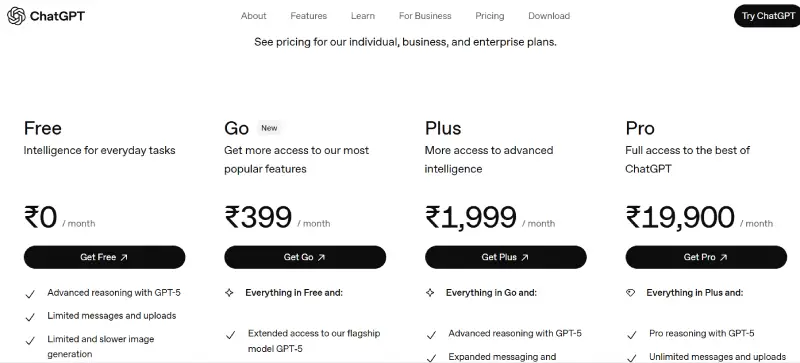India is a key market in the gold rush for the next billion AI users, writes Satyen K. Bordoloi
In October, Google surprised India by announcing a partnership with Reliance to offer Jio subscribers a complimentary Google AI Pro subscription for 18 months, valued at ₹35,100. Earlier in the month, OpenAI had announced that it would give a ₹399 per month ChatGPT Go subscription to every Indian for free.
Google itself has been offering a free year’s subscription to students since July. Additionally, if you are an Airtel user, you can claim a free year’s subscription to Perplexity Pro. CoPilot was already being offered free on Microsoft Windows Laptops. Now, training a large language model is expensive, and running it is even more so.
So why are these AI companies, which have yet to turn a profit in their AI businesses, giving away their tools for free to Indians?
Do not for a moment consider this philanthropy, because behind these moves lies an extremely well-thought-out strategy to capture what many consider the world’s most valuable digital market, where these companies see an unprecedented opportunity in filling India’s indigenous AI gap. Our national failure in the artificial domain space is triggering these AI companies’ profit instincts.

A PARADOX CALLED DIGITAL INDIA
All of the 25 years of this digital millennium have fared India well. We took late steps in the digital domain as a nation, but we made up for it well enough to have a strong pool of IT talent that is the envy of the world. Today, the heads of the biggest and smallest AI companies, from established giants like Google and Microsoft to new entrants like Perplexity and Luma Labs, have Indians at the helm.
Yet, it is also true that we have decisively missed the AI boat within the borders of our ancient nation. So much so that even as countries like the UAE build their own LLMs, India, with its deep and vast digital talents, has not been able to create one of its own. We do not even have good India-specific datasets.
The result is a dichotomy, a paradox in the AI field where there are no notable Indian companies in the global race, or even in the foundational aspects of AI. When it comes to building tools on top of existing models, we have done our fair share. Yet, that is not nearly enough because we have a billion internet users, making us the second-largest internet market after China.
Naturally, India’s AI market is projected to expand exponentially, fuelled by rapid digital transformation across sectors and supportive government initiatives. And I’m not even talking about enterprise adoption, where, as per some figures, 80% of Indian businesses now prioritise AI implementation, surpassing global averages. This will naturally result in a significant increase in investment in AI tools in India.
Yet, while the US produced over 40 notable AI models in 2024 and China 15, India has yet to make a truly globally competitive Gen AI platform or model.

THE UNTAPPED INDIAN MARKET
With the kind of population that we have, and the demographic dividend of a young population, global tech firms understand that establishing dominance in India today would yield exponential returns tomorrow. And even in the field of AI growth, India is a huge nation to gather data, refine models and to test AI. Like I do not tire of saying, that any self-driving car that works in India, will work anywhere else in the world.
Various initiatives – both from the government and private sector have made our nation fertile for the taking. Indian mobile companies give the cheapest internet connection in the world, while government initiatives like Digital India and UPI mean millions are used to digital interfaces. Thus, with our 830 million internet users and thousands of crores worth of digital transactions, India has an ecosystem ripe for AI integration.
Add to that the fact that India has one of the world’s youngest populations alongside the tag as the world’s fastest-growing major economy, and you have the perfect conditions for exponential AI adoption across industries and individuals seeking a competitive advantage.

FIRST MOVER ADVANTAGE
India’s inability to produce a foundational AI model that can compare with a Western or Chinese alternative has created a strategic vacuum that global companies are eager to fill. Before a viable local alternative emerges, global AI companies see a once-in-a-lifetime opportunity to establish market dominance.
China imposes numerous restrictions on foreign companies. India is comparatively much more open, which means global AI companies will face limited local competition here. Thus, the first-mover advantage will be crucial for these companies, as the network effect can create competitive advantages for those who prioritise growing their user base over immediate revenue. The free subscriptions are thus nothing but user acquisition costs in a price-sensitive market.
The other reason for the move could also be a prized commodity today: data. India’s incredible linguistic diversity, comprising 22 national languages and thousands of dialects, presents both a challenge and an opportunity for AI companies. Free services offer these companies valuable user interaction, which can help them refine their models not just for India, but for the world.

Code-switching, i.e., the mixing of languages in conversation, along with our varied cultural contexts and distinct communication patterns, will help AI companies create globally useful AI models and products.
And let’s not forget the question of digital sovereignty. The concentration of AI powers in the hands of foreign companies means India will be beholden to these countries and companies. Hence, these ‘free’ AI subscriptions flooding the Indian market is neither about corporate philanthropy nor simple customer acquisition strategies. They are a tactical move to gain money and influence in the long run.
As a nation, our future depends on how we navigate this period, both collectively and individually. If we can leverage these global technologies to build our own capabilities, we will rise in the world. But if the lure of free AI today leads us to stop AI innovation, what will happen to us as a nation will be precisely what happened to Jio users in 2016: free Jio sims and data got the nation hooked to the network, after which they went for the kill, and today the data and network costs are higher than they were in 2016. Jio, Airtel and others have come up with the same AI Trojan Horse as a gift for all of us.
Will it be beneficial for us, or will we follow the same Jio route? Only time will tell.
In case you missed:
- Why Elon Musk is Jealous of India’s UPI (And Why It’s Terrifyingly Fragile)
- From Generics to Genius: The AI Revolution Reshaping Indian Pharma
- Digital Siachen: Why India’s War With Pakistan Could Begin on Your Smartphone
- Google Falters Under AI Onslaught: Future of Search in Peril?
- How India Can Effectively Fight Trump’s Tariffs With AI
- The Major Threat to India’s AI War Capability: Lack of Indigenous AI
- Deep Impact: How Cheap AI like DeepSeek Could Upend Capitalism
- And Then There Were None: The Case of Vanishing Mobile SD Card Slots
- Why the Alleged, Upcoming AI Crash Is Never Going To Happen
- Digital Siachen: How India’s Cyber Warriors Thwarted Pakistan’s 1.5 Million Cyber Onslaught










